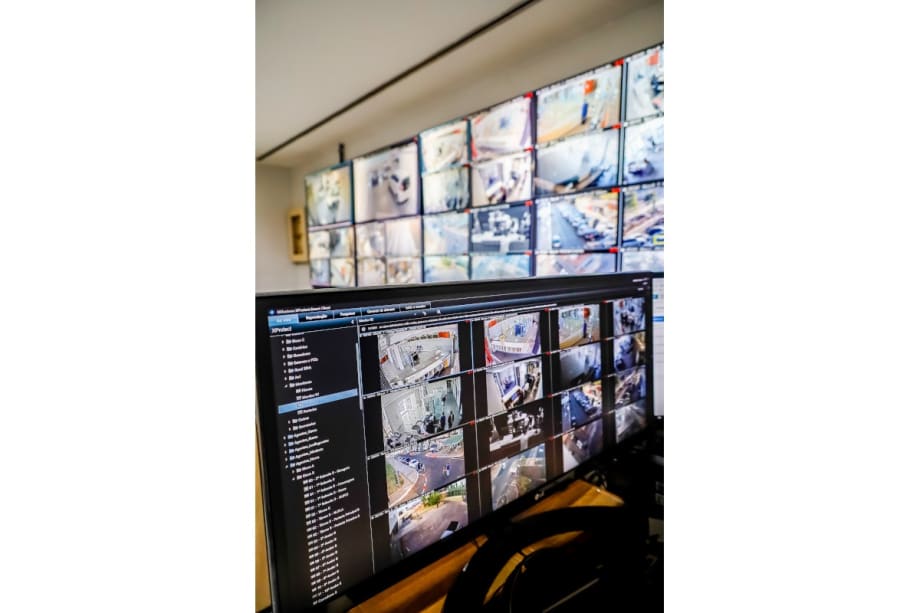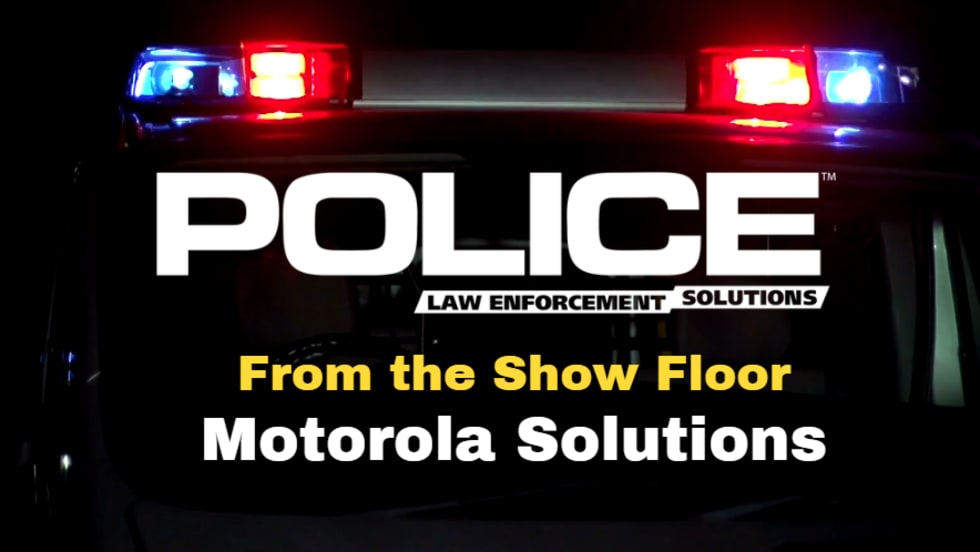As law enforcement agencies adopt more technology-driven policing tactics, real time crime centers (RTCC) are evolving as hubs for leveraging a wide range of data. RTCCs can integrate data from security cameras, gunshot sensors, and many other technologies to help identify threats and guide law enforcement responses in real time. By enhancing situational awareness and information sharing, RTCCs allow agencies to direct resources quickly and effectively, translating into faster response times, higher clearance rates, reduced crime, and greater safety and security for their citizens.
How Technology Powers Real Time Crime Centers
An effective real time crime center relies on the integration of a multitude of technologies to provide comprehensive monitoring and rapid response capabilities.

Real time crime center displays running Milestone Systems’ XProtect Expert VMS.
Milestone
RTCCs operate 24/7 to proactively support daily law enforcement activities. As technology-driven policing becomes the norm, RTCCs allow agencies to capitalize on the vast amounts of digital information available today.
What is an RTCC?
A real time crime center is a centralized location with dedicated personnel that utilize various systems and technologies to analyze disparate data sets and provide information and support to law enforcement operations. The core function of an RTCC is data gathering, analysis, and sharing information to aid in decision making and response coordination.
The mission of an RTCC is to centralize a broad range of current and evolving technologies, coordinate sworn and non-sworn human resources, and direct the attention of both to high-crime areas, active crimes in progress, high-profile or highly recidivistic offenders, and large-scale public events that may require law enforcement presence or response, according to the Bureau of Justice Assistance at the U.S. Department of Justice.
RTCCs can increase their effectiveness and situational awareness across a city or region by setting up notifications and alerts that trigger based on predefined rules, activity, or behavior. RTCC operators monitor and analyze live data streams from various sources like security cameras, gunshot detection systems, automated license plate readers (LPRs), social media monitoring, computer-aided dispatch systems, criminal databases, and more. Advanced analytics and mapping software help operators quickly visualize, correlate, and share relevant information with officers in the field and partner agencies.
Unlike traditional policing, which is very reactive in nature, RTCCs take a more proactive approach and are helping law enforcement agencies do more with less. This is extremely important given the lack of human resources and the increased need to be more strategic and efficient with the resources they have. While structures vary across agencies, RTCCs allow cities to fully leverage technologies for more effective, efficient policing. While implementations may differ, successful real time crime centers share three core pillars:
Safety: Enhancing officer and public safety is the primary mission of the centers. RTCCs provide intelligence and increased situational awareness to officers responding to priority calls.
Identification: RTCCs leverage video, LPR data, criminal records, and other information to identify suspects in a timely manner. For example, if a robbery occurs, the RTCC can quickly search cameras and LPR data to track the suspect vehicle and assist officers in apprehending the perpetrators.
Apprehension: RTCC operators can monitor high crime locations for criminal activity, providing dispatch and responding officers with targeted and strategic real-time information to identify, locate, and apprehend suspects in a proactive and timely manner. Cameras placed in high-crime areas allow RTCCs to watch for offenses and direct responding officers appropriately.
Technology Fuels Capabilities
An effective real time crime center relies on the integration of a multitude of technologies to provide comprehensive monitoring and rapid response capabilities. Integrating these technologies within an open platform video management system with dashboards, geospatial mapping, and AI-powered analytics is crucial for maximizing efficiency and capabilities. This creates a common operating picture with role-based access to data that has the flexibility to be scaled up incrementally as needs and budgets evolve. With the seamless integration of the right technologies, RTCCs gain the situational awareness and swift analysis needed to proactively identify threats and efficiently dispatch resources for faster incident resolution.
Some of the technologies involved include:
IP Cameras: A network of high-resolution fixed and pan-tilt-zoom (PTZ) cameras provides 24/7 live monitoring and recording capabilities. Camera networks can give situational awareness across all city areas, including transit hubs, event venues, shopping districts, high-crime areas, and other hot spots.
LPR Systems: Automated license plate recognition analytic software can track vehicle movements across a city, generating real-time alerts when stolen, wanted, or suspect vehicles are detected. LPR systems can result in dramatic reductions in auto thefts, vehicle recovery, and locating/tracking suspect vehicles fleeing a crime scene.
Sensor Networks: Gunshot detection systems place acoustic sensors across high-crime areas to instantly detect gunfire and cue cameras and officers. Air quality sensors can identify hazardous conditions, and noise detection can alert on explosions or shouts.
Database Access: Direct connections to local, state, and federal databases, like the National Crime Information Center (NCIC), allow real-time queries on individuals to assess threats. Integrations with gang databases, probation records, and more provide context.
Video Analytics: AI-powered video analytics can detect anomalies and threats like unattended bags, intrusions, people or vehicles in restricted areas, and a range of suspicious behaviors. Smart analytics can rapidly sift through thousands of hours of video from multiple cameras to identify key events and activities in a matter of minutes.
Mapping Software: Visualizing events, alerts, and data geospatially on maps and dashboards accelerates response coordination. Operators can clearly see relationships and clusters of activity.
Drones: Some agencies have drones on standby that RTCC operators can deploy for aerial views of emergency scenes, traffic accidents, hostage situations, and other critical events.
Open Platform Video Management: A unified, open platform video management system (VMS) can pull together all the cameras, sensors, and data into a joint operating view in a unified, single pane of glass, accessible in real-time. The system allows the integration of best-in-breed cameras, sensors, analytics, and other systems using open APIs and software development kits (SDKs). Data-driven video technology is essential for pushing alerts both to the RTCC and officers in the field through the VMS mobile app.
Cloud Connectivity: Equally important, an open platform enables flexibility and scalability through cloud integrations. Cloud and hybrid cloud/on-premises solutions provide affordable, highly secure off-site storage while offering easy video sharing and scalable bandwidth on demand. This reduces upfront costs while enabling enhancements over time. With tight budgets, prioritizing cloud integrations allows cash-strapped agencies to boost RTCC capabilities incrementally.
Making a Difference
Estimates show there are more than 80 RTCCs nationwide, focusing on a number of public safety issues such as violent crimes, homicides, robberies, drugs, and assaults.
The RTCC in Winston-Salem, NC, for example, monitors a network of cameras sourced from public and private entities (who share feeds). This real-time video surveillance helps the RTCC combat crime. Using a gunfire detection system and a pilot program for automated license plate readers—aimed not at traffic enforcement but at assisting investigations—the center recently proved its efficiency. Following a shooting, officers at the center tracked the suspects via cameras, guiding on-site officers directly to the suspects' location, allowing swift apprehension and firearm retrieval.
In many U.S. cities, RTCCs are providing police departments with game-changing crime-fighting capabilities. For example, after unveiling its RTCC in 2021 Newport News, VA, saw an immediate boost in solving crimes. Most notably, the city was able to capture homicides on video, as well as quickly solve a series of carjacking cases.
RTCCs also help police gather evidence and solve cases faster. In one incident in Memphis, a shooting occurred at a community basketball court. When police arrived, the suspects fled in different directions. Officers detained as many people as possible. Later, RTCC detectives reviewed the video data and identified the shooter—who was already in police custody. Although no witnesses had pointed out the shooter, the video evidence allowed police to apprehend the culprit.
The Jackson (MS) Police Department has seen similar benefits since building an RTCC in 2019, part of a broader effort that included deploying 100 cameras and 271 body cameras. Officers and analysts can view street and body camera footage to monitor crowds at parades and other events. During pursuits, the cameras provide extra surveillance, allowing officers to identify suspects or witnesses to help solve crimes.
According to a recent report from the Bureau of Justice Assistance, the conceptual definition and the actual implementation of an RTCC may be very different depending on resources; the nature of crime in a community, citizen, governmental, and other stakeholder interests; and a host of other factors.
Technology-Driven Policing
As technology-driven policing gains traction, the establishment and growth of real time crime centers will continue nationwide. Video analytics leveraging AI and machine learning will continue to evolve and enhance current capabilities, further improving RTCC insights and automation. Drone adoption will accelerate with expanding FAA waivers, granting RTCCs low-cost aerial surveillance.
RTCCs offer an integrated approach to crime prevention, leveraging vast data sources to proactively identify threats and guide law enforcement responses. They exemplify modern proactive policing rather than just reactive measures. Success stories from U.S. cities underscore the tangible benefits of RTCCs in reducing violent crime, improved clearance rates, and considerable returns on investment.
As the landscape of law enforcement evolves, so does the need for RTCCs' continuous training, embracing open platforms for scalability, and ensuring effective planning and collaboration. As these centers become more common, their role will be pivotal in maximizing limited resources and driving real-time, data-informed decisions for safer communities.
Jason Tyre is business development manager, cities, for Milestone Systems.
More Technology

Flock Safety and Coreforce Partner to Enhance Real-Time Awareness and Operational Efficiency for Law Enforcement
A new integration partnership will enable Flock Safety hotlist alerts and license plate recognition (LPR) searches directly in Coreforce’s Real-Time Crime Center (RTCC) and Digital Evidence Management System (DEMS) platform.
Read More →
From the Show Floor: DroneSense by Versaterm
Learn about DroneSense by Versaterm as POLICE talks with Ryan Bracken, head of product. He explains the rapid advancements in drone technology, capabilities, and software.
Read More →
From the Show Floor: Versaterm
Learn more about Versaterm as POLICE visits with Rohan Galloway-Dawkins, chief product officer, to explore the company’s focus on a purpose-built platform for public safety.
Read More →
From the Show Floor: Motorola Solutions
In this video, learn about the Motorola Solutions ecosystem and how it provides tools that enhance the efficiency and safety of police officers. You’ll hear about the APX NEXT radio and SVX system, Assisted Narrative, and more.
Read More →
Learning How to Manage Your Fleet?
Watch this tutorial on how fleet management platforms work. You’ll see how easily you can integrate fleet telematics, dash cameras, and asset management in a single pane of glass and manage your fleet more effectively.
Read More →
From the Show Floor: Semtech
Learn about the latest ruggedized routers designed for public safety vehicles as POLICE visits with Greg Hill of Semtech. These routers are equipped with the latest 5G technology.
Read More →
Genetec Showcases Its Latest Public Safety Innovations at IACP 2025
Genetec demonstrated its Cloudrunner, Citigraf, and Clearance during IACP 2025 to show how they can provide law enforcement with a unified situational awareness to make cities safer.
Read More →
Ohio’s Statewide Drone First Responder Program to Take Flight
Over the next two years, the Ohio DFR Pilot Program will equip municipalities with advanced drone systems, deliver comprehensive training for first responders, and enable FAA-approved Beyond Visual Line of Sight operations.
Read More →
Tampa Police Department Deploys More Than 950 5G Smartphones
Tampa Police Department has deployed more than 950 5G-enabled smartphones through Verizon Frontline to support its Connected Officer initiative and enhance field communications.
Read More →
Getac Introduces F120 Rugged Tablet and V120 Rugged Laptop
The new devices feature larger displays, AI-ready processors, and enhanced durability for police and first responders working in demanding environments.
Read More →
